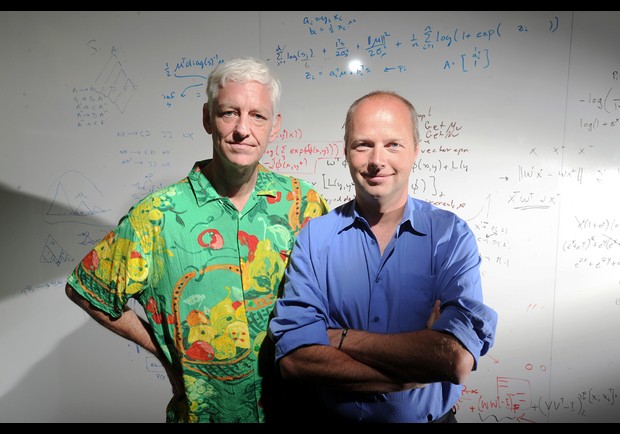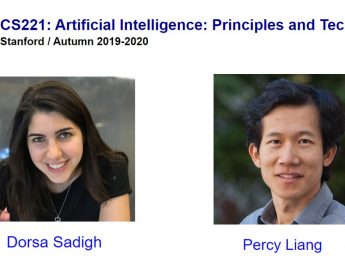Artificial Intelligence (AI) is a science and a set of computational technologies that are inspired by—but typically operate quite differently from—the ways people use their nervous systems and bodies to sense, learn, reason, and take action.
In other word, Artificial intelligence is the branch of computer science concerned with making computers behave like humans.
The frightening, futurist portrayals of Artificial Intelligence that dominate films and novels, and shape the popular imagination, are fictional. In reality, AI is already changing our daily lives, almost entirely in ways that improve human health, safety, and productivity. Unlike in the movies, there is no race of superhuman robots on the horizon or probably even possible. And while the potential to abuse AI technologies must be acknowledged and addressed, their greater potential is, among other things, to make driving safer, help children learn, and extend and enhance people’s lives. In fact, beneficial AI applications in schools, homes, and hospitals are already growing at an accelerated pace. Major research universities devote departments to AI studies, and technology companies such as Apple, Facebook, Google, IBM, and Microsoft spend heavily to explore AI applications they regard as critical to their futures. Even Hollywood uses AI technologies to bring its dystopian AI fantasies to the screen. (ARTIFICIAL INTELLIGENCE AND LIFE IN 2030 – REPORT OF THE 2015 STUDY PANEL)

Artificial Intelligence (AI) is a field that has a long history but is still constantly and actively growing and changing. Artificial Intelligence (AI) technology is increasingly prevalent in our everyday lives. It has uses in a variety of industries from gaming, journalism/media, to finance, as well as in the state-of-the-art research fields from robotics, medical diagnosis, and quantum science.
 Udacity was born out of a Stanford University experiment in which Sebastian Thrun and Peter Norvig offered their “Introduction to Artificial Intelligence” course online to anyone, for free. Over 160,000 students in more than 190 countries enrolled and not much later, Udacity was born.
Udacity was born out of a Stanford University experiment in which Sebastian Thrun and Peter Norvig offered their “Introduction to Artificial Intelligence” course online to anyone, for free. Over 160,000 students in more than 190 countries enrolled and not much later, Udacity was born.
Udacity, a pioneer in online education, is building “University by Silicon Valley”, a new type of online university that:
– teaches the actual programming skills that industry employers need today;
– delivers credentials endorsed by employers, because they built them;
– provides education at a fraction of the cost and time of traditional schools.
With industry giants – Google, AT&T, Facebook, Salesforce, Cloudera, etc. – Udacity offers Nanodegree credentials, designed so professionals become Web Developers, Data Analysts, or Mobile Developers. Supported by Udacity communities of coaches and students, Udacity students learn programming and data science through a series of online courses and hand-on projects that help them practice and build a convincing portfolio.

Stanford professors Peter Norvig and Sebastian Thrun are offering their ever popular Introduction to AI for free on the internet.
https://www.udacity.com/course/intro-to-artificial-intelligence–cs271
Norvig and Thrun, leaders in artificial intelligence, are using automated systems to help them at every level of the massive endeavour, from deciding which questions to answer to grading final exams.
In this course, you’ll learn the basics and applications of AI, including: machine learning, probabilistic reasoning, robotics, computer vision, and natural language processing.
It is free and it takes approximately 4 months. You can enroll in this course on Udacity and start learning there at once..
https://www.udacity.com/course/intro-to-artificial-intelligence–cs271
All courses’ videos have been uploaded by Udacity on Youtube..
“Artificial Intelligence Course was made in 2011 by Peter Norvig and myself at Stanford University and became basically the first very large massive open online course 160,000 students at the time then sparked the development of many many other such courses. The course is comprised of many units covering all the bases in artificial intelligence. It’s modelled after the very successful book by Stuart Russel and Peter Norvig which is the number one book on artificial intelligence and I really hope you get to enjoy this class it’s the original class diving.” Sebastian THRUN, Co-FOUNDER&CEO, UDACITY
Welcome to the Artificial Intelligence class on Udacity. Sebastian Thrun and Peter Norvig are your teachers. You can take this class at your own pace. You need to match up the quizzes, the homework assignments, the midterm and the final exam to succeed in this course.
THE PURPOSE OF THIS CLASS :
1. TO TEACH YOU THE BASICS OF ARTIFICIAL INTELLIGENCE (so you’ll be able to talk to people in the field and understand the basic tools of the trade)
2. TO EXCITE YOU ABOUT THE FIELD
“I have been in the field of artificial intelligence for about years, and it’s been truly rewarding. So I want you to participate in the beauty and the excitement of AI so you can become a professional who gets the same reward and excitement out of this field as I do.” Peter Norvig
STRUCTURE OF THIS COURSE:
*VIDEOS
*QUIZZES (which will ask you about your ability to answer AI questions)
*ANSWER VIDEOS ( which we tell you what the right answer would have been for the quiz that you might have falsely or incorrectly answered before.)
*ASSIGNMENT (you get a homework assignment also in the form of quizzes)
*VIDEO EXAMS
QUIZ:
AI PROGRAM IS CALLED ?
a. WETWARE
b. FORMULA
c. INTELLIGENT AGENT
QUIZ: (answer)
AI PROGRAM IS CALLED
a. WETWARE
b. FORMULA
c. INTELLIGENT AGENT (CORRECT)
Intelligent agent gets to interact with an environment. The agent can perceive the state of the environment through its sensors, and it can affect its state through its actuators. The big question of artificial intelligence is the function that maps sensors to actuators. That is called the control policy for the agent. So all of this class will deal with how does an agent make decisions that it can carry out with its actuators based on past sensor data. Those decisions take place many, many times, and the loop of environment feedback to sensors, agent decision, actuator interaction with the environment and so on is called perception action cycle.
 QUIZ:
QUIZ:
AI HAS SUCCESSFULLY BEEN USED IN ?
a. FINANCE
b. ROBOTICS
c. GAMES
d. MEDICINE
e. THE WEB
f. NONE OF THEM
QUIZ: (answer)
AI HAS SUCCESSFULLY BEEN USED IN
a. FINANCE (correct)
b. ROBOTICS (correct)
c. GAMES (correct)
d. MEDICINE (correct)
e. THE WEB (correct)
f. NONE OF THEM

“Every time you try to write a piece of software, that makes your computer software smart, likely you will need artificial intelligence. In this course, Peter and I will teach you many of the basic tricks of the trade to make your software really smart.” Sebastian Thrun
Some basic terminology that is commonly used in artificial intelligence to distinguish different types of problems.
FULLY VERSUS PARTIALLY OBSERVABLE:
An environment is called fully observable if what your agent can sense at any point in time is completely sufficient to make the optimal decision. For example, in many card games, when all the cards are on the table, the momentary site of all those cards is really sufficient to make the optimal choice.
That is in contrast to some other environments where you need memory on the side of the agent to make the best possible decision. For example, in the game of poker, the cards aren’t openly on the table, and memorizing past moves will help you make a better decision.
To fully understand the difference, consider the interaction of an agent with the environment to its sensors and its actuators, and this interaction takes place over many cycles, often called the perception-action cycle.
For many environments, it’s convenient to assume that the environment has some sort of internal state. For example, in a card game where the cards are not openly on the table, the state might pertain to the cards in your hand. An environment is fully observable if the sensors can always see the entire state of the environment.
It’s partially observable if the sensors can only see a fraction of the state, yet memorizing past measurements gives us additional information of the state that is not readily observable right now.
So any game, for example, where past moves have information about what might be in a person’s hand, those games are partially observable, and they require different treatment. Very often agents that deal with partially observable environments need to acquire internal memory to understand what the state of the environment is.
DETERMINISTIC VERSUS STOCHASTIC:
Deterministic environment is one where your agent’s actions uniquely determine the outcome. So, for example, in chess, there’s really no randomness when you move a piece. The effect of moving a piece is completely predetermined, and no matter where I’m going to move the same piece, the outcome is the same. That we call deterministic.
Games with dice, for example, like backgammon, are stochastic. While you can still deterministically move your pieces, the outcome of an action also involves throwing of the dice, and you can’t predict those. There’s a certain amount of randomness involved for the outcome of dice, and therefore, we call this stochastic.
DISCRETE VERSUS CONTINUOUS:
A discrete environment is one where you have finitely many action choices, and finally many things you can sense. So, for example, in chess, again, there are finally many board positions, and finally many things you can do.
That is different from a continuous environment where the space of possible actions or things you could sense may be infinite. So, for example, if you throw darts, there’s infinitely many ways to angle the darts and to accelerate them.
BENIGN VERSUS ADVERSARIAL:
In benign environments, the environment might be random. It might be stochastic, but it has no objective on its own that would contradict the own objective.
So, for example, weather is benign. It might be random. It might affect the outcome of your actions. But it isn’t really out there to get you.
Contrast this with adversarial environments, such as many games, like chess, where your opponent is really out there to get you. It turns out it’s much harder to find good actions in adversarial environments where the opponent actively observes you and counteracts what you’re trying to achieve relative to benign environment, where the environment might merely be stochastic but isn’t really interested in making your life worse.


CHECKERS
FULLY OBSERVABLE/DETERMINISTIC/DISCRETE/ADVERSARIAL

POKER
PARTIALLY OBSERVABLE/STOCHASTIC/ADVERSARIAL

ROBOTIC CAR
PARTIALLY OBSERVABLE/STOCHASTIC/CONTINUOUS
Artificial Intelligence is the technique of uncertainty management in computer software. AI is the discipline that you apply when you want to know what to do when you don’t know what to do.
There’s many reasons why there might be uncertainty in a computer program. There could be a sensor limit. That is, your sensors are unable to tell me what exactly is the case outside the AI system. There could be adversaries who act in a way that makes it hard for you to understand what is the case. There could be stochastic environments. Every time you roll the dice in a dice game, the stochasticity of the dice will make it impossible for you to be absolutely certain of what’s the situation. There could be laziness. So, perhaps you can actually compute what the situation is, but you computer program is just too lazy to do it. Ignorance; many people are just ignorant of what’s going on. They could know it, but they just don’t care. All of these things are cause for uncertainty.
AI is the discipline that deals with uncertainty and manages it in decision making.
One of the best successes of AI technology at Google has been the machine translation system.
In Unit 1;
Key Applications of Artificial Intelligence
Definition of an Intelligent Agent
4 Key Attributes for Artificial Intelligence (partial observability, stochasticity, continuous spaces, and adversarial natures)
Sources and management of uncertainty
Mathematical concept of rationality are touched any of these issues superficially but as this class goes on you’re going to dive into any of those and learn much more about what it takes to make a truly intelligent AI systems.
Artificial Intelligence (AI) is a field that has a long history but is still constantly and actively growing and changing. Artificial Intelligence (AI) technology is increasingly prevalent in our everyday lives. It has uses in a variety of industries from gaming, journalism/media, to finance, as well as in the state-of-the-art research fields from robotics, medical diagnosis, and quantum science.
Unit 2, Topic 1, Introduction
Unit 2, Topic 2, Route Finding Question
Unit 2, Topic 3, Route Finding
Unit 2, Topic 4, Tree Search
Unit 2, Topic 5, Tree Search Answer
Unit 2, Topic 6, Graph Search
Unit 2, Topic 7, Graph Search Answer
Unit 2, Topic 8, Graph Search Answer
Unit 2, Topic 9, More Graph Search
Unit 2, Topic 10, Graph Search Answer
Unit 2, Topic 11, Graph Search Termination
Unit 2, Topic 12, Uniform Cost Search
Unit 2, Topic 13, Uniform Cost Search
Unit 2, Topic 14, Uniform Cost Search
Unit 2, Topic 15, Uniform Cost Search
Unit 2, Topic 16, Uniform Cost Termination
Unit 2, Topic 17, Uniform Cost Termination Answer




